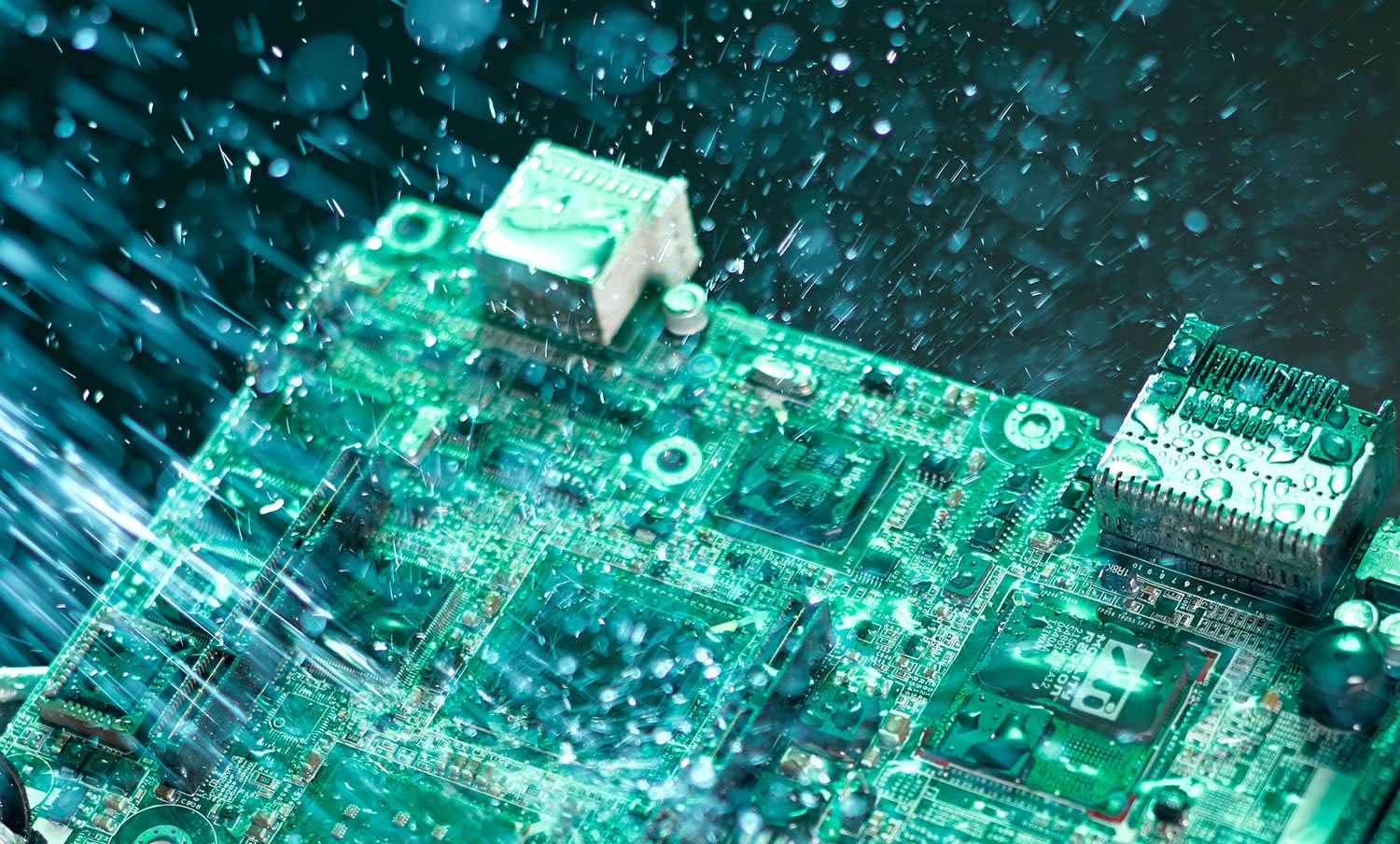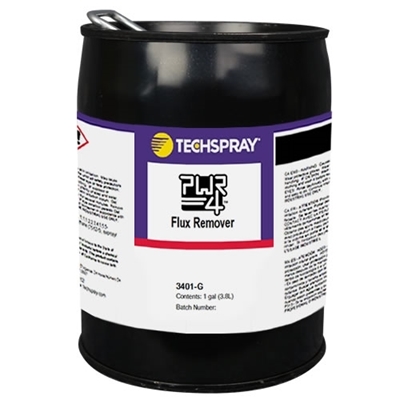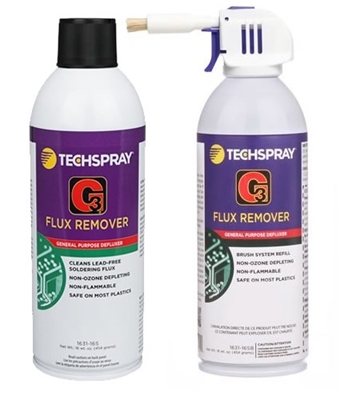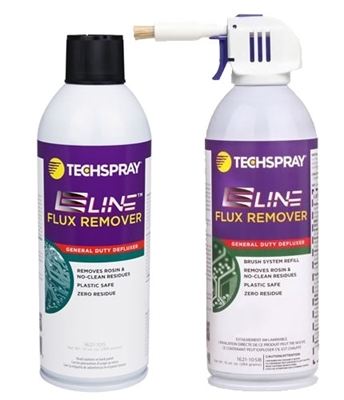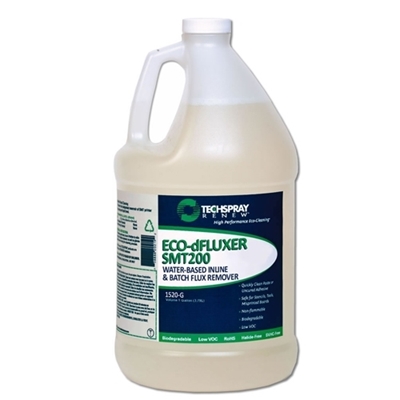Nicole Bass:
Hi, I’m Nicole Bass, Product Manager for Techspray conformal coatings…
Jessica Cadena:
and I’m Jessica Cadena, Product Manager for cleaning chemistries. Today we’re going to take you through the importance of cleaning before applying conformal coating, and some tips for setting up the process.
Nicole Bass:
A conformal coating is a thin layer of polymer applied to electronic components or circuit boards to protect them from environmental factors like moisture, dust, chemicals, and mild mechanical stressors.
The goal of conformal coating is to increase durability and improve reliability of electronic devices, extending their life in harsh environments.
They are commonly used in industries like electronics, automotive, aerospace, and medical electronics.
How about I explain the advantage of cleaning your printed circuit board assembly, or PCBA, before coating.
Let’s face it, you aren’t coating for the fun of it. You are coating because it is required, either because of an extreme operating environment for the electronic device, and/or the critical nature of the device’s reliable operation.
Cleaning is all about eliminating hard-to-control variables from your process, so you can focus on the primary factors that will get you defect-free coating and highest reliability of the final device.
Your primary factors include:
- Your choice of conformal coating
- Viscosity
- Equipment settings
- Masking keep-out areas
If hand spraying…
- Spray pressure
- Speed of the spray pass
- Spray direction
If dipping…
- Insertion speed
- Withdrawal speed
And finally…
- Cure time
- Cure temperature
When you leave contamination on the PCBA, you can introduce a number of additional variables…
- High surface energy or poor wettability of the surface, which can hurt adhesion. That can lead to dewetting, where the liquid coating backs away, or delamination, where the cured coating blisters and peels away.
- Ambient humidity, which can absorb into flux residue and increase the chances of electrochemical migration.
- Chemical interaction of the coating and residue, which can increase the likelihood of defects like bubbles.
Manufacturing environments often have inherent fluctuations in temperature, humidity, and other conditions. A wide process window accounts for these variations, reducing the likelihood of defects caused by minor deviations. This robustness leads to higher yields and fewer rejected PCBs.
So Jessica, how about you take us through the kinds of contamination we are worried about?
Jessica Cadena:
There are a number of contaminants that are commonly found on PCBAs…
- Residual etchants from the original bare board fabrication.
- Dust from bare board drilling, cutting and scoring.
- Fingerprints and skin oils from board handling.
- Silicone and other oils migrating from other processes.
What we’re going to be focusing on are flux residues, because they’re the most common concern.
During the soldering process, flux is used to facilitate the soldering of components onto the PCB.
If not properly cleaned, leftover flux residues can lead to coating issues, corrosion, electrical leakage and shorts.
Rosin and aqueous fluxes should always be removed as soon as possible after the soldering process. This is because these fluxes leave behind ionic material. Dendrites, or conductive branches, are formed when ionic residue meets with humidity and an electrical current.
These conductive branches have been known to even form underneath conformal coating, leading to current leakage and eventually electrical shorts.
It’s pretty much universally understood that rosin and aqueous fluxes need to be cleaned, so they’re not our main concern here.
On the other hand, no-clean fluxes are often left on the PCBA, even when the boards will be coated.
Nicole Bass:
Well they are called “no-clean”, so they shouldn’t cause a problem, right?
Jessica Cadena:
You would think so, but that’s a bit of a misnomer. These fluxes are called “no-clean” because most of the ionic material is consumed in the soldering process. Whatever ionic residue is left is encapsulated in what’s called a benign glassy state.
The ionic residues are basically sealed up so it won’t interact and cause dendrites.
This benign layer can be disrupted, like from an ineffective cleaning process, where the solvent removes the benign layer, but leaves behind some of the ionic material underneath.
Nicole Bass:
So, if cleaning solvents can disrupt the benign layer, the aggressive carrier solvents used in conformal coating, like acetone, xylene, could really cause issues. You would either release the ionic contamination underneath the coating, or totally dissolve the residues and distribute it within the resin, impacting the integrity of the cured coating.
Jessica Cadena:
Is conformal coating water-proof enough to keep the moisture away, effectively sealing off the ionic residue?
Nicole Bass:
Conformal coatings are moisture resistant and generally hydrophobic, so they repel water, but most aren’t waterproof. Even if applied heavily, most coatings are semi-permeable, so they still allow some amount of moisture through. Also, moisture could be absorbed by the flux residue even before the coating process.
Another concern is even if the residue is harmless, you have a layer between the surface and the coating. That could wet differently, causing dewetting, or not adhere as well, causing blistering or delamination.
So the cleaning before coating is strongly recommended, even with no-clean flux.
Jessica, assemblers accustomed to no-clean fluxes may not have an established cleaning process. Where is a good place to start?
Jessica Cadena:
The best cleaning method for your operation depends on your volume, throughput desired, criticality of the electronics, regulatory restrictions, and floor space.
The main options for board cleaning are…
- Manual cleaning - This can involve aerosol or pump sprays, or solvents in a pan or tray. Agitation can be applied with a brush, swab or wipe.
- Ultrasonic - This method uses sound waves to create bubbles, which implode on the PCBA surface to break up the flux residues.
- Vapor degreasing - The cleaning is done either in the vapor phase of a solvent, or submerged in a sump, which often includes ultrasonic action.
- Batch or inline systems - Spray equipment with water-based cleaners wash, rinse, and dry the PCBAs.
I’ll focus on aerosol cleaning, because that is the most practical if you are setting up a new cleaning operation.
All defluxing processes basically involve…
- Dissolving the flux residue:
Choose a cleaner that works best with your flux. A good match will reduce the need for extra soak time and agitation. When flux has been sitting for a long period of time, or has been baked on at high temperature or long reflow cycle, addition brushing might be required. - Flushing or rinsing off the dissolved residues:
Remember, once flux residues are dissolved, they won’t just evaporate off. They need a chance to flow off the circuit board. Holding the board at an angle while you are cleaning can help. A final rinse is always a good idea, and required if you are using a water-based cleaner. - Drying the printed circuit board assembly (PCBA):
For fast-drying solvents, this isn’t usually an issue. For water-based cleaners, you can accelerate drying with a duster, or use alcohol as a drying agent.
Nicole Bass:
And once the PCBA is clean and dry, it is ready for the coating process.
So to recap, cleaning the printed circuit board assembly before the conformal coating process gives you the widest possible process window. This will give you greater production efficiency, product quality, and overall reliability.
Remember, Techspray offers state-of-the-art cleaning, coating and analytical services to help you qualify new products and optimize your process. This is offered free of charge if you are considering one of our products. Please contact Techspray when you are ready to get started.

